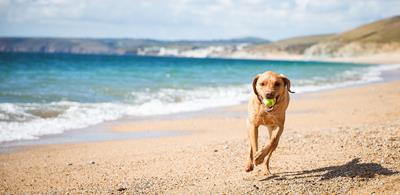
The sun’s shining, the sky is blue, it’s definitely the perfect weather for a dog walk… or is it? While your canine companion may love their daily dose of exercise and fresh air, taking them for a stroll when it’s too warm can be harmful to their health.
The Dog’s Trust recommends holding the palm of your hand against the pavement for five seconds. If it’s uncomfortable for you, it’s too hot for your dog’s paws. Easy.
AT A GLANCE
1. When the temperature reaches 20oC or higher, it’s usually too hot for walkies
2. Walking dogs when it’s too hot can lead to dehydration or heatstroke
3. Planning walks for late evening or early morning, and opting for shaded routes is advisable
How hot is too hot to walk dogs?
Most experts agree that temperatures below 20oC are perfectly safe for walking your dog. However, above this level it starts to get too hot, with the potential risks to your dog’s health getting greater as the temperature rises.
At one or two degrees hotter, humans might not even notice the difference, but with their furry coats and the fact they aren’t very efficient at cooling themselves down, dogs are likely to be extremely uncomfortable.
What are the risks?
Their difficulty coping with extreme heat means dogs face a number of risks in a heatwave, including dehydration and heatstroke, which can be fatal. There’s also the risk they’ll burn the sensitive pads of their paws on the pavement, and, just like humans, they can get sunburn.
All dogs are at risk from the heat, but some are more vulnerable, including:
- Overweight dogs
- Puppies younger than six months
- Dogs older than eight years
- Certain breeds, including French Bulldogs and Pugs.
Don’t miss: Should you break a car window to save a dog from overheating?
Signs to be aware of
During heatwaves it’s worth keeping an extra close eye on your dog so you can spot any signs that they’re struggling as early as possible.
Signs of burnt paws
- Limping
- Licking their feet
- Darker paw pads
- Blisters or redness
Signs of heatstroke
- Heavy panting
- Excessive drooling
- Appearing drowsy or lethargic
- Lack of co-ordination
- Vomiting or diarrhoea
If you’re concerned about heatstroke, it’s important to contact your vet immediately and take action to help your pet cool down by moving them to a shaded area and placing them on top of a cool towel or cooling mat.
Check this out: Going on holiday abroad with your dog – what you need to know
Top tips for keeping your dog cool on walks
To help keep your dog safe in warmer weather, while still enjoying regular ‘walkies’, there are a few things you can do:
- Plan your strolls for early morning and late evening – before 8am or after 8pm is usually coolest.
- Choose a shaded route – ideally flat and not too far. You can also avoid pavements and sand and stick to grassy areas.
- Take a collapsible bowl and bottle of water, so they can hydrate mid walk
- Keep them well groomed – having less fur will make it easier to keep cool
Other ways to exercise your dog
If you’re struggling to find a time when it’s cool enough to walk your dog, don’t panic, it won’t cause any harm to miss the odd walk. In fact, when it’s hot, you might want to be limiting exercise anyway. Here are a few alternative activities to try:
- Play in the paddling pool – fill it with cool water in a shady spot and let them enjoy a splash. Limit their time if they get too overexcited and start overheating.
- Brain games – try mental rather than physical stimulation to keep your dog busy without getting too hot. Refresh their basic training, teach some new tricks or challenge them to sniff out some treats.
- Get the sprinkler out – and let them play in the water. You can also use a spray bottle.
Keep your pet happy and healthy with pet insurance that’s Easy As. Get your free Ageas pet insurance quote today.


